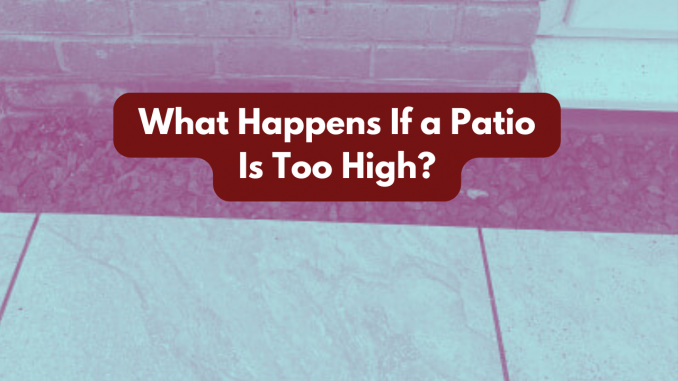
Patios are an essential feature of many gardens, providing a versatile outdoor space for relaxation, dining, and entertaining. However, the height of your patio can significantly affect both its functionality and its compliance with building regulations. If you’re wondering whether your patio is too high or what the consequences of an elevated patio might be, this guide will provide the answers you need.
How High Should a Patio be?
In the UK, patios should generally not be raised more than 300mm (approximately 12 inches) above the ground without requiring planning permission. If you plan to construct a patio higher than this, you should check with your local council to ensure compliance with building regulations.
The Dangers of a High Patio
Determining whether your patio is too high involves considering several factors, including building regulations, privacy concerns, and the impact on your home’s drainage. Here’s what to look out for:
Compliance with Building Regulations
In the UK, patios that are raised more than 300mm (approximately 12 inches) above ground level are subject to planning permission requirements. If your patio exceeds this height and you haven’t obtained the necessary permissions, it may be deemed non-compliant and you’ll need for it to be altered or even removed.
Water Drainage Problems
Improper drainage due to a high patio can cause water to pool around the base of your home. Over time, this can lead to structural issues such as damp walls, foundation damage, or flooding in your basement.
Neighbour Complaints
A raised patio that overlooks neighbouring gardens can lead to privacy complaints. In some cases, neighbours may escalate the issue to local authorities, resulting in an investigation and potential enforcement actions.
Safety Concerns
High patios without proper railings or barriers can pose a safety risk, especially for children and elderly individuals. A fall from a raised patio could lead to serious injuries.
Reduced Property Value
A patio that is too high and poorly integrated into the garden’s design might deter potential buyers. It could be viewed as a flaw that requires additional expense to rectify, thereby lowering your home’s market appeal.
What to Do If Your Patio Is Too High
If you’ve identified that your patio might be too high, there are steps you can take to address the issue:
Apply for Retrospective Planning Permission
If your patio exceeds the height limit and wasn’t approved beforehand, you can apply for retrospective planning permission. While there’s no guarantee it will be granted, this is the first step to ensuring compliance.
Install Privacy Screens or Fencing
To address privacy concerns, consider adding screens, fencing, or tall plants around the perimeter of your patio. This can create a more secluded space while reducing the impact on your neighbours.
Improve Drainage
If water drainage is an issue, consult a landscaper or drainage specialist to install proper channels or soakaways. These adjustments can help redirect water away from your home.
Lower the Patio Height
In extreme cases, you may need to lower the height of your patio. While this can be costly, it’s often the best long-term solution to avoid planning violations and drainage issues.
Add Safety Features
If lowering the patio isn’t an option, ensure it is equipped with railings or barriers to prevent accidents. This is particularly important if the patio is used by children or individuals with mobility challenges.
The height of your patio plays a critical role in its functionality, safety, and compliance with regulations. If you suspect your patio is too high, it’s essential to address the issue promptly to avoid potential problems down the line. By understanding the consequences of a high patio and implementing practical solutions, you can create an outdoor space that is not only beautiful but also compliant and safe for everyone to enjoy.

Leave a Reply